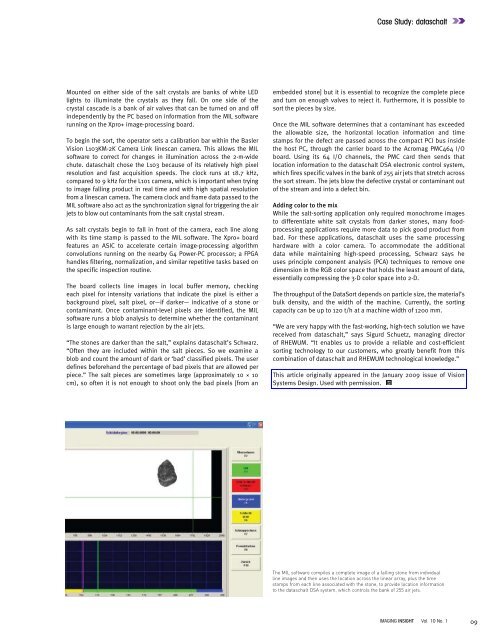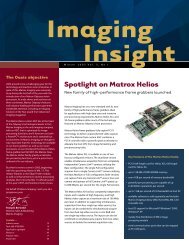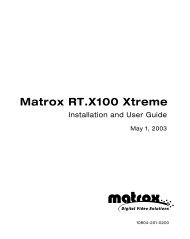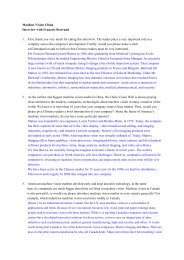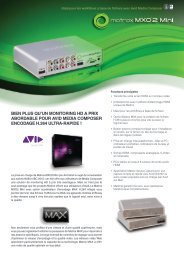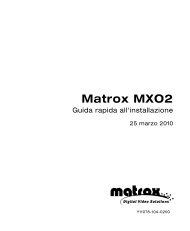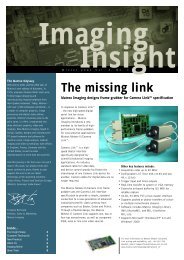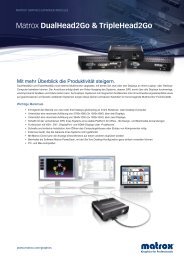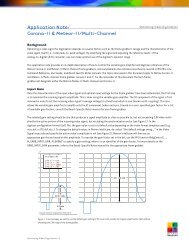Create successful ePaper yourself
Turn your PDF publications into a flip-book with our unique Google optimized e-Paper software.
Mounted on either side of the salt crystals are banks of white LED<br />
lights to illuminate the crystals as they fall . On one side of the<br />
crystal cascade is a bank of air valves that can be turned on and off<br />
independently by the PC based on information from the MIL software<br />
running on the Xpro+ image-processing board .<br />
To begin the sort, the operator sets a calibration bar within the Basler<br />
Vision L103KM-2K Camera Link linescan camera . This allows the MIL<br />
software to correct for changes in illumination across the 2-m-wide<br />
chute . dataschalt chose the L103 because of its relatively high pixel<br />
resolution and fast acquisition speeds . The clock runs at 18 .7 kHz,<br />
compared to 9 kHz for the L101 camera, which is important when trying<br />
to image falling product in real time and with high spatial resolution<br />
from a linescan camera . The camera clock and frame data passed to the<br />
MIL software also act as the synchronization signal for triggering the air<br />
jets to blow out contaminants from the salt crystal stream .<br />
As salt crystals begin to fall in front of the camera, each line along<br />
with its time stamp is passed to the MIL software . The Xpro+ board<br />
features an ASIC to accelerate certain image-processing algorithm<br />
convolutions running on the nearby G4 Power-PC processor; a FPGA<br />
handles filtering, normalization, and similar repetitive tasks based on<br />
the specific inspection routine .<br />
The board collects line images in local buffer memory, checking<br />
each pixel for intensity variations that indicate the pixel is either a<br />
background pixel, salt pixel, or—if darker— indicative of a stone or<br />
contaminant . Once contaminant-level pixels are identified, the MIL<br />
software runs a blob analysis to determine whether the contaminant<br />
is large enough to warrant rejection by the air jets .<br />
“The stones are darker than the salt,” explains dataschalt’s Schwarz .<br />
“Often they are included within the salt pieces . So we examine a<br />
blob and count the amount of dark or ‘bad’ classified pixels . The user<br />
defines beforehand the percentage of bad pixels that are allowed per<br />
piece .” The salt pieces are sometimes large (approximately 10 × 10<br />
cm), so often it is not enough to shoot only the bad pixels [from an<br />
Case Study: dataschalt<br />
embedded stone] but it is essential to recognize the complete piece<br />
and turn on enough valves to reject it . Furthermore, it is possible to<br />
sort the pieces by size .<br />
Once the MIL software determines that a contaminant has exceeded<br />
the allowable size, the horizontal location information and time<br />
stamps for the defect are passed across the compact PCI bus inside<br />
the host PC, through the carrier board to the Acromag PMC464 I/O<br />
board . Using its 64 I/O channels, the PMC card then sends that<br />
location information to the dataschalt DSA electronic control system,<br />
which fires specific valves in the bank of 255 air jets that stretch across<br />
the sort stream . The jets blow the defective crystal or contaminant out<br />
of the stream and into a defect bin .<br />
Adding color to the mix<br />
While the salt-sorting application only required monochrome images<br />
to differentiate white salt crystals from darker stones, many foodprocessing<br />
applications require more data to pick good product from<br />
bad . For these applications, dataschalt uses the same processing<br />
hardware with a color camera . To accommodate the additional<br />
data while maintaining high-speed processing, Schwarz says he<br />
uses principle component analysis (PCA) techniques to remove one<br />
dimension in the RGB color space that holds the least amount of data,<br />
essentially compressing the 3-D color space into 2-D .<br />
The throughput of the DataSort depends on particle size, the material’s<br />
bulk density, and the width of the machine . Currently, the sorting<br />
capacity can be up to 120 t/h at a machine width of 1200 mm .<br />
“We are very happy with the fast-working, high-tech solution we have<br />
received from dataschalt,” says Sigurd Schuetz, managing director<br />
of RHEWUM . “It enables us to provide a reliable and cost-efficient<br />
sorting technology to our customers, who greatly benefit from this<br />
combination of dataschalt and RHEWUM technological knowledge .”<br />
This article originally appeared in the January 2009 issue of Vision<br />
Systems Design . Used with permission .<br />
The MIL software compiles a complete image of a falling stone from individual<br />
line images and then uses the location across the linear array, plus the time<br />
stamps from each line associated with the stone, to provide location information<br />
to the dataschalt DSA system, which controls the bank of 255 air jets.<br />
IMAGING INSIGHT Vol. 10 No. 1<br />
09


